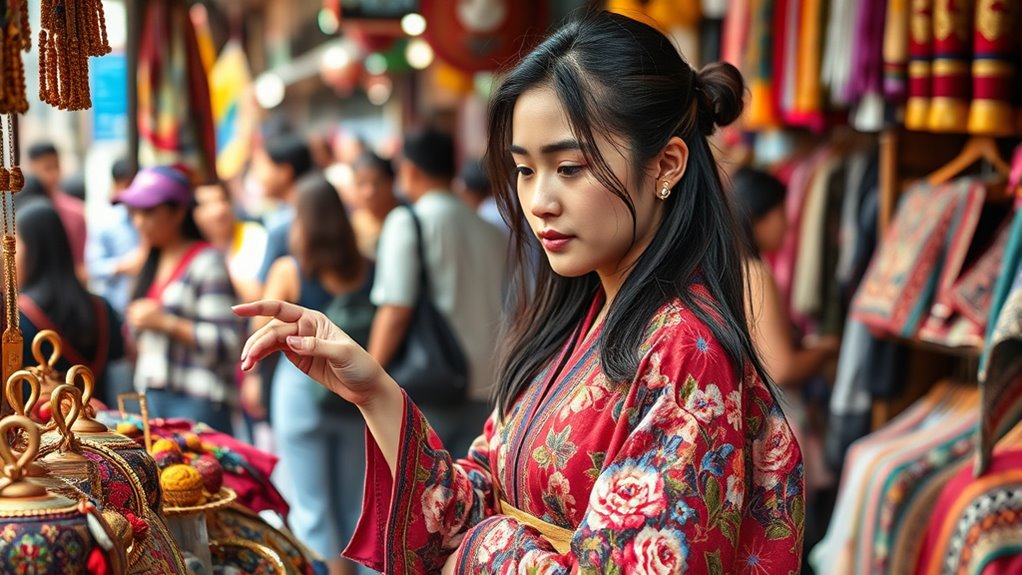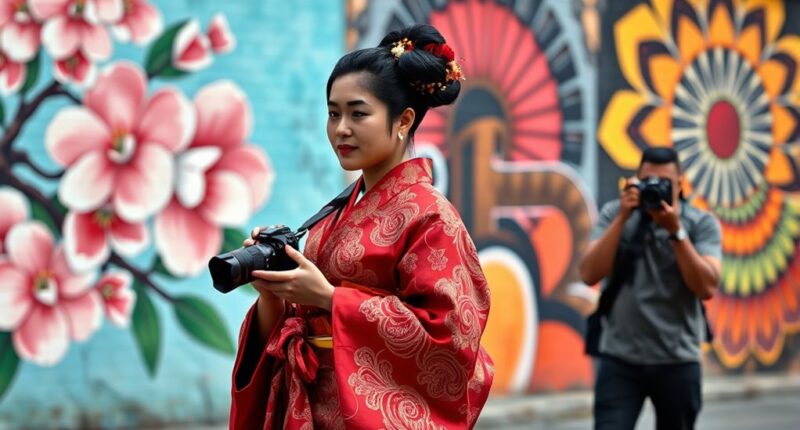Understanding the difference between cultural appropriation and appreciation is key to respectful creativity. Appropriation happens when you take cultural elements out of context for trends or personal gain, often disregarding their significance. Appreciation, on the other hand, involves genuinely respecting and understanding cultural symbols, techniques, and traditions. By approaching cultures with curiosity and humility, you can honor their meanings and support authentic exchange. Keep exploring to discover how you can engage thoughtfully and honorably with diverse traditions.
Key Takeaways
- Cultural appropriation involves taking elements out of context for personal gain, often disregarding their significance; appreciation involves respectful sharing and understanding.
- Superficial engagement reduces traditional garments to trendy costumes, perpetuating stereotypes and diminishing cultural value.
- Genuine cultural exchange requires researching origins, respecting symbolism, and engaging with artisans or ethical brands.
- Recognizing personal biases and understanding the cultural significance behind styles helps prevent misappropriation.
- Approaching traditions with humility and a desire to learn fosters respectful interactions and promotes cultural inclusivity.

Understanding the difference between cultural appropriation and appreciation is essential in today’s interconnected world. When you engage with other cultures, it’s easy to unintentionally cross the line from respectful admiration to disrespectful exploitation. This is especially true in fashion, where stereotypes and superficial understandings often shape perceptions. Fashion stereotypes can distort the significance of traditional garments, reducing them to trendy accessories or costume ideas. Instead of recognizing the profound cultural meaning behind certain styles, some might wear them simply for aesthetic appeal, ignoring the history and significance they carry. This kind of superficial engagement can perpetuate harmful stereotypes and diminish the cultural value of traditional attire.
Superficial engagement with traditional garments can reinforce stereotypes and diminish their cultural significance.
On the other hand, cultural exchange invites a genuine sharing of ideas, techniques, and stories. When you approach other cultures with curiosity, respect, and a desire to learn, you foster authentic connections rather than superficial trends. Appreciating a culture’s fashion, for example, involves understanding its origins and respecting its significance. You can incorporate elements into your wardrobe thoughtfully, perhaps by researching their meaning or seeking out artisans or brands that prioritize cultural integrity. This approach transforms fashion from a superficial trend into a meaningful act of cultural exchange. It shows that you value and respect the traditions behind the styles, rather than merely using them as a costume or a fleeting trend.
It’s also vital to be aware of your own biases and to avoid reducing complex cultures to stereotypes. When you educate yourself about the history and context of the clothing or symbols you’re interested in, you’re less likely to inadvertently perpetuate harmful notions. This awareness helps you distinguish between appreciation, which seeks understanding and respect, and appropriation, which often involves taking elements out of context or for personal gain. Engaging thoughtfully with other cultures can also foster cultural sensitivity, promoting mutual respect and understanding rather than superficial imitation. When you engage in cultural exchange thoughtfully, you help break down stereotypes and promote a more inclusive, respectful dialogue. You empower marginalized communities by honoring their heritage rather than commodifying it for personal or commercial purposes.
In essence, respecting cultural differences means recognizing the depth and significance behind the styles and symbols you encounter. Whether you’re exploring fashion, art, or traditions, aim to approach them with humility and a genuine desire to learn. This respectful attitude not only enriches your understanding but also helps foster a more inclusive, interconnected world where cultural exchange is celebrated responsibly, and stereotypes are challenged rather than reinforced.
Frequently Asked Questions
How Can I Learn About Cultural Significance Respectfully?
To learn about cultural significance respectfully, start by researching the cultural history behind traditions, symbols, or practices. Engage in respectful dialogue with members of that community, listening actively and asking thoughtful questions. Avoid assumptions and recognize your own biases. By approaching with humility and openness, you honor their cultural heritage and deepen your understanding, fostering genuine appreciation rather than appropriation.
What Are Common Signs of Cultural Insensitivity?
You should watch for cultural insensitivity signs like relying on cultural stereotypes or using disrespectful symbolism. Avoid generalizations that reduce a culture to a single image or idea, and be cautious of appropriating symbols without understanding their significance. If you notice someone making jokes or wearing items that mock or trivialize a culture, it’s a clear sign of disrespect. Always aim to learn and show genuine respect instead of perpetuating harmful stereotypes.
How Do Cultural Exchanges Differ From Appropriation?
Cultural exchanges differ from appropriation because they respect cultural boundaries and focus on mutual understanding. When you engage in genuine exchanges, you honor the community’s identity preservation and seek permission or collaboration. Appropriation, however, often involves taking elements without consent, stripping them of meaning. By being mindful of these boundaries, you foster respectful creativity, appreciating cultures without disrespecting their roots or reducing their significance.
Can Cultural Appreciation Be Expressed Through Fashion?
You can definitely express cultural appreciation through fashion by thoughtfully incorporating fashion symbolism and style influence from different cultures. When you do this with respect, you honor origins and avoid stereotypes. Choose pieces that celebrate the meaning behind designs, and acknowledge their cultural significance. This way, your fashion choices become a respectful tribute, showcasing genuine appreciation rather than cultural appropriation. Your style can be a powerful form of respectful cultural exchange.
What Role Does Intent Play in Cultural Appreciation?
Have you ever wondered if your intentions truly matter in cultural expression? Intent plays an essential role in cultural appreciation because it guides whether your actions stem from meaningful respect and genuine understanding or risk cultural insensitivity. When your purpose is rooted in honoring traditions with respectful curiosity, it fosters authentic connections. Without clear intent, even well-meaning gestures can unintentionally cause harm. So, ask yourself: are your actions driven by respect or superficial interest?
Conclusion
By respecting others’ cultures, you hold the power to prevent causing wounds that run deeper than any ocean. When you choose appreciation over appropriation, you become a beacon of genuine understanding and kindness. Remember, your actions can either build bridges or burn them—so don’t let ignorance turn your creative spark into a wildfire of disrespect. Embrace cultural exchange thoughtfully, and you’ll create a world where everyone feels valued and truly seen.










